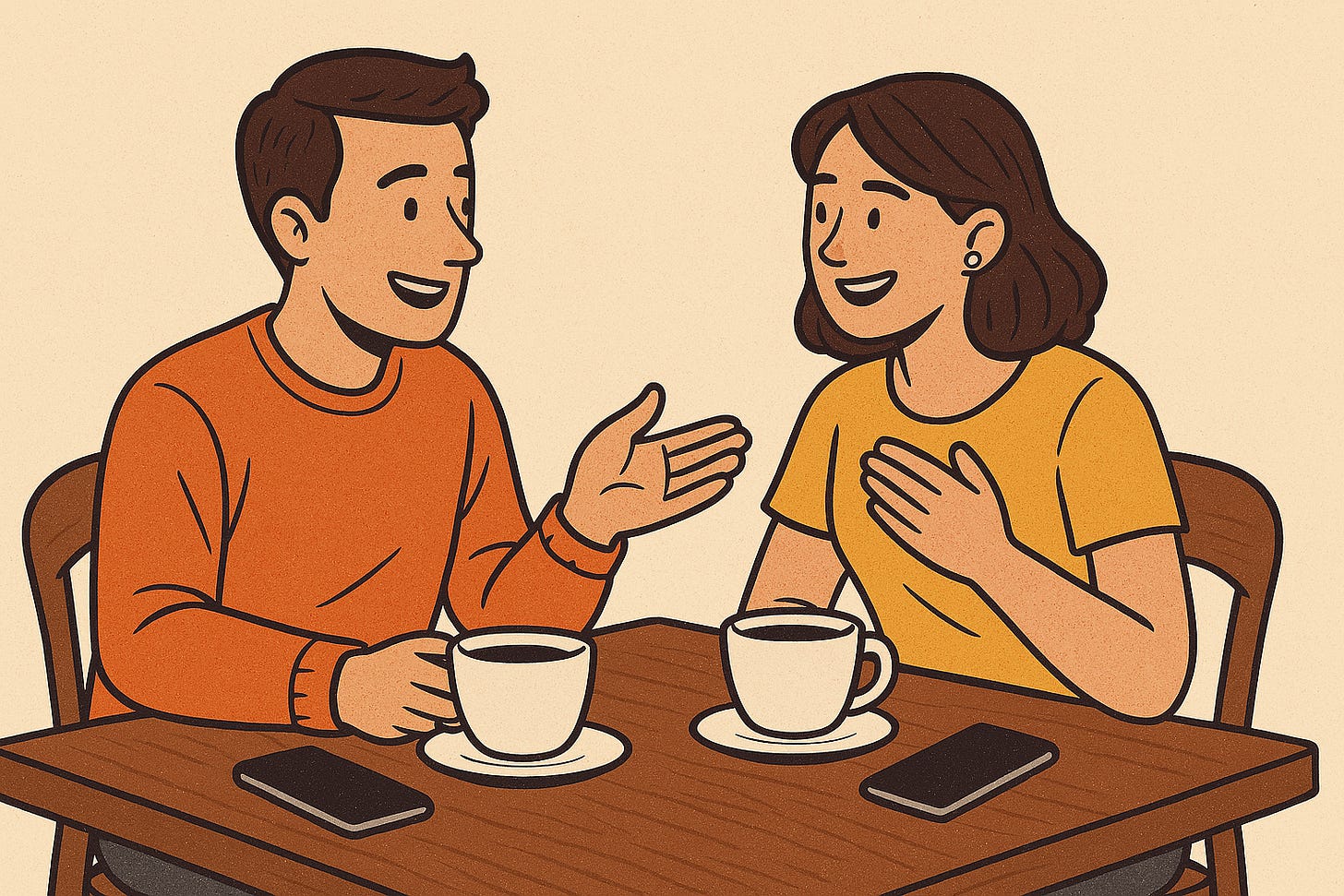Two articles, both of which were meant to be quick ones and ended up becoming long, at least for my standards. A Training Plan For Cognitive Fitness summarizes Cal Newport’s advice to reclaim brain power in our distracted ecosystem. DMs Are Great. So Is Dinner is a commentary on recent post on meals and solitude.
A training plan for cognitive fitness
To get smarter, you need to put in the reps.
Originally published on giolodi.com on 2025/04/06.
In two recent episodes of his podcast Deep Questions, Cal Newport shared a training plan for cognitive fitness.
The episodes are #345: Are We Getting Dumber? and #346: Getting Smarter in a Dumb World. I recommend watching them, but here’s an annotated summary.
Level 1: Maintaining cognitive fitness
These are the cognitive equivalent of daily movement, hydration, and sleep. The basics to counteract the effect social media, work chats, and…
Read
As Cal is fond of saying, “reading is calisthenics for the brain.” And while listening to books is valuable, it’s reading on paper that really trains your brain—see The Reader’s Brain for more details. It doesn’t matter what you read; anything goes, from pulp paperback fiction to dense idea books.
Pursue cognitively demanding hobbies
Whether it’s playing an instrument, learning a manual craft, or my recent favorite, solving twisty puzzles, engage in leisure activities that require concentration. This will keep you entertained in an active way, as opposed to the passive doomscrolling that shrinks your attention span.
Go on reflection walks
Walking has many positive effects for the body. You can double dip by using walking to train your concentration. Pick up a problem to reflect upon and focus on it during your walk. When you notice your attention wandered off, gently push it back on track. (See also How To Walk More Without Changing Your Schedule.)
Avoid stimuli stacking
Smartphones are so convenient to carry around and the social media apps so engaging that you can find yourself watching TV while scrolling on Instagram. This growing tendency damages our ability to focus, because the brain gets used to distractions. It also takes away from the experience: if you divide your attention between TV and Instagram, you’ll enjoy neither. I often fall into this with podcasts at lunchtime. I’ll eat while listening to something and get to the end of my meal without having enjoyed a single bite.
Level 2: Improving cognitive fitness
If you think of the exercises above as the equivalent of keeping your body in motion, getting enough rest, and following a healthy nutrition, then the following exercises are like following a training plan to compete in a triathlon. They are meant to take your cognitive fitness to the next level.
Dialectical reading
When interacting with ideas, intentionally seek opposite views. This exercise will force you to engage with ideas seriously, questioning your assumptions and criticizing the opposition. The goal is not to change your mind, it’s to put it through a rigorous exercise.
Become a connoisseur
Take your hobby up a notch by becoming a student of it. Dive deep into the history and the details to develop taste. This deeper level of engagement requires focus and dedication, which is a great exercise for the mind. It will also raise the quality bar you’ll accept for your inputs, another safeguard against the kind of leisure activity that degrades your focus.
Keep an ideas document
Moving from input to output is another method of interacting with ideas that benefits your cognition. Write about the ideas you care about as an exercise to deepen both your understanding and your thinking—for clear writing is clear thinking.
Focus interval training
How long can you engage with a problem without caving in to distractions? Can you stick with something for 90 minutes, without checking Slack, or your phone, or whichever quick fix for boredom you use? These are questions of focus endurance, a skill that can be systematically improved. Whatever your current level, aim for 10 minutes more over the next two weeks. Obviously, the interval can’t stretch indefinitely, but 90 minutes is a duration often recommended as the sweet spot between having enough time to make progress without depleting the brain’s fuel and stamina to the point where it can no longer perform.
Curate your digital diet
This final advice is more of a practice than an exercise to repeat. Think of it as the equivalent of eating the right food to fuel muscle recovery as part of your training plan. Today’s digital entertainment and information landscape is unfortunately optimized for shallowness and emotional engagement. As I wrote in The Sherlock Holmes Information Diet, “when fed a diet of trivial nonsense, our brains will never have the raw materials for producing deep thoughts.”
Cal’s exercise regimen for cognitive fitness came as a reaction to the provocative Financial Time piece by John Burn-Murdoch Have humans passed peak brain power? (paywalled). For what is worth, I agree with James Pethokoukis in thinking we are far from a peak. In fact, we might be at the beginning of a new climb thanks to more technological augmentation—but, this is just me prophesying.
Regardless of what some observational studies find about the cognitive prowess of their participants, we can all benefit from training our brain.
As a father, how well I can focus impacts both the quality of the time I spend with my kids and my ability to earn a living for them.
Cal’s exercises might not address the root causes of what can sometimes feel like an incurable distraction epidemic, but are a great way for individuals to strengthen their immune system against it. “All you need to do” is put in the reps.
DMs Are Great. So Is Dinner.
On balancing digital connection with real-world presence.
In Eating alone in the age of connection,
reflects on the growing trend of people eating alone—or, rather, in the sole company of their smartphones.The ritual of shared meals, long a touchstone of human connection, now competes with the distraction of screens. The smartphone is the silent, omnipresent companion.
But, Gloria argues, this comes at the expense of our quality of life:
The tradition of commensality—sharing meals together—has long been revered across cultures. It is more than just a means of sustenance; it’s a marker of community, a statement that life is richer when shared.
Sharing meals and drinks is a tradition that dates back many thousands of years.
In A History of the World in 6 Glasses, Tom Standage traces the ritual of sharing a drink as far back as the third millennium AD.
From the start, it seems that beer had an important function as a social drink. Sumerian depictions of beer from the third millennium BCE generally show two people drinking through straws from a shared vessel. By the Sumerian period, however, it was possible to filter the grains, chaff, and other debris from beer, and the advent of pottery meant it could just as easily have been served in individual cups. That beer drinkers are, nonetheless, so widely depicted using straws suggests that it was a ritual that persisted even when straws were no longer necessary.
The most likely explanation for this preference is that, unlike food, beverages can genuinely be shared. When several people drink beer from the same vessel, they are all consuming the same liquid; when cutting up a piece of meat, in contrast, some parts are usually deemed to be more desirable than others. As a result, sharing a drink with someone is a universal symbol of hospitality and friendship.

As our working environments become increasingly remote and distributed, it can be tempting to focus on online relationships, especially for introverts. After all, it’s more likely to find job opportunities and people with similar interests online.
The new online relationships can be deep, useful, and satisfying, but in growing them we shouldn’t neglect the offline relationships that ground us. We still need real, in-person connections.
And it’s the same technology that some attack as the culprit for the erosion of in-person connections that creates the opportunity to spend more time together. Take remote work, for example. If a company operates in a truly distributed way, employees have plenty of flexibility for coffee or lunch dates with friends
And while most job opportunities are likely to come from your online network, there’s much more that can come from nourishing offline relationships with people you can actually share a space with. Which is why, by the way, remote companies invest in bringing distributed teams together in the same location throughout the year.
Looking into a smartphone during a meal can keep you connected to faraway friends—which is wonderful, as long as it doesn’t disconnect you from those right in front of you. It’s all about finding the ratio that works for you.
When we use our time and devices intentionally, we can build strong online networks and deepen real-world bonds.



